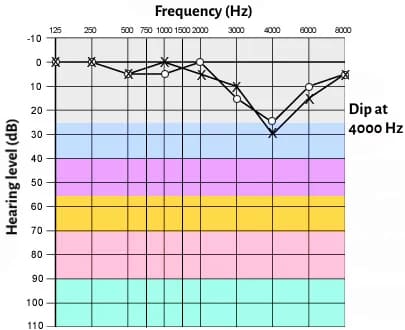Noise induced trauma. Hearing loss due to exposure to loud noise is one of the most prevalent, potentially preventable, source of health impairment. The sources of such noise are usually seen during gunfire exposure, motor-racing, boiler makers, iron and coppersmiths, artillery men or while using personal music devices. Noise trauma is mainly a occupational hazard and involves financial compensations if employee gets hearing loss.
Hearing loss caused by excessive noise can be divided into two types:
1. Acoustic Trauma. Also called as impulse noise is described as a condition where a single exposure to a very intense sound leads to an immediate deafness without being preceded by a temporary threshold shift . Such impulsive noise can arise from an explosion, gunfire exposure or a powerful cracker and may reach 140 –170 dB SPL (sound pressure level). It can lead to permanent changes in the affected ear. A very loud noise can mechanically damage tympanic membrane, disrupt ossicles, organ of Corti, tear Reissner’s membrane, rupture hair cells and allowing mixing of inner ear fluids.
2. Noise-Induced Hearing Loss (NIHL). The term noise-induced hearing loss (NIHL) refers to a reduction in auditory acuity as a consequence of excessive chronic noise exposure. It is mainly a hazard of noisy occupations. The condition may be of two types:
- Temporary threshold shift (TTS). There is immediate hearing loss following exposure to noise but recovers after few days to months.
- Permanent threshold shift (PTS). The hearing impairment is permanent and does not recover at all. PTS may occur following repeated noise exposures, or following a single episode (acoustic trauma).
Factors causing damage to hearing loss are as follows:
- Frequency of noise. A sound ranges between 2k-3k Hz frequency causes more damage than the other frequencies.
- Intensity and duration of noise. Damage is directly proportional to duration and intensity of noise exposure. The sound exposure below 80 dB(A) are unlikely to cause hearing damage, while sounds of 130 dB(A) or more will cause hearing damage after even short time periods. The permissible time or safe period of exposure decreases as the intensity of sound level increases.
- Continuous vs interrupted noise. Continuous noise is more damaging than the interrupted noise.
- Susceptibility of the individual. Degree of TTS and PTS on particular individual from excessive noise exposure are different and relatively unpredictable.
- Pre-existing ear disease.
- Predisposing Factors: Smoking, diabetes, cardiovascular disease, blue eye colour, recreational drug use, exposure to ototoxic agents.
Pathophysiology:
The pathological manifestations mainly occur in cochlea during noise trauma, although the tympanic membrane and ossicles may also get damaged. TTS mainly involves metabolic changes and PTS is mainly due to structural changes.
The pathophysiological changes are:
- Metabolic changes are mainly because of change in cochlear blood flow following noise exposure. A sound of moderate intensity increases cochlear blood flow, while sound of high intensity decreases cochlear blood flow. Therefore, sound of high intensity causes cochlear hypoxia which leads to cochlear dysfunction.
- Stuructural changes are depolymerization of actin filaments in stereocilia and swelling of the stria vascularis, afferent nerve endings and supporting cells.
- Apoptosis and necrosis of outer hair cells.
- Damage to inner hair cells, basilar membrane and spiral ganglion cells leading to degeneration of organ of Corti.
Diagnosis.
- History. Patient presents with complaint of decreased hearing typically of SNHL type with or without tinnitus or hyperacusis. There is prolonged history of unprotected exposure to excessive noise. In cases of acoustic trauma there may be acute stress reaction, otalgia and imbalance along with above symptoms.
- Tinnitus is generally seen along with hearing loss but sometimes it is the first symptom without complaints of hearing difficulties.
- Hyperacusis is an abnormal growth or increased sensitivity to certain frequencies of sound. It is seen in 40% of patients having complaints of tinnitus.
- Examination. Local ear examination can be normal or injury to tympanic membrane and ossicles may be present.
- Investigation. The cornerstone of investigation is a pure-tone audiogram. There is good preservation of mid and low frequencies but a significant hearing loss with classical notching at 4–6kHz. The notch is symmetrical in both ears at 4kHz or 6 kHz with some recovery at 8kHz, both for air and bone conduction. The notch deepens as noise exposure increases. However, all audiograms showing a notch at 4000 Hz are not due to noise-induced hearing loss and not all noise induced hearing loss present the typical 4000 Hz notch. Other tests like tympanometry (acoustic reflex), tone decay, SISI test may show cochlear pathology. It may also help to detect instances of malingering.

Why 4 kHz dip?
- Anatomical location of 4 kHz area of the basilar membrane corresponds to that area of basal turn (of cochlea) where it is firmly attached and therefore more prone for torsion and pressure changes in the perilymph.
- More prone for vascular injuries in this area.
- Reflex contraction of intratympanic muscles in response to loud sounds shift the sound towards higher frequencies.
- Due to increase resonance of external auditory, meatus, there is increase in amplitude of sound waves in this frequency level.
Prevention. Persons working in noisy surroundings especially if noise is above 85 dB.
- Should have pre-employment
- Annual audiograms for early detection.
- Should wear ear protectors (ear plugs or ear muffs) or other hearing protective devices. They provide protection up to 35 dB.
HEARING ATTENUATION PROVIDED BY DIFFERENT DEVICES
| Cotton wool | 5 dB |
| Ear plug | 15–30 dB (mostly in range of 3–5 kHz) |
| Ear muffs | 30–40 dB (500–1 kHz) |
| Ear plugs + muffs | More than 40 dB |
Note: Hearing protectors provide more attenuation in higher frequencies, 25–40 dB for 1k-8k Hz while only 10–30 dB attenuation for lower frequencies less than 500 Hz.
Government norms for prevention of NIHL. A noise of 90 dB (A) SPL, 8 h a day for 5 days per week is the maximum safe limit as recommended by Ministry of Labour, Govt. of India, Model Rules under Factories Act. No exposure more than 115 dB (A) is to be permitted. No impulse noise of intensity more than 140 dB (A) is permitted.
The Noise Pollution (Regulation and Control) Rules 2000, Ministry of Environment and Forest, Govt. of India has defined permissible limits of noise for various zones or areas. According to which silence zone is 100 m around the premises of hospitals, nursing homes, educational institutions and courts.
| Noise level (dBA) | Permitted daily exposure (h) |
| 90 | 8.0 |
| 92 | 6.0 |
| 95 | 4.0 |
| 97 | 3.0 |
| 100 | 2.0 |
| 102 | 11/2 |
| 105 | 1.0 |
| 110 | 1/2 |
| 115 | 1/4 |
Permissible limits of time for various intensity levels for the safety of ear.
5 dB rule of time intensity states that “any rise of 5 dB noise level will reduce the permitted noise exposure time to half.”
Specific treatment.
- Once a diagnosis is made, further noise exposure should be reduced by the use of ear protection devices in the form of earplugs or earmuffs. It reduces the further risk of NIHL.
- Hearing aids may provide benefit as here is no way to replace the hearing that has been lost.
- Tinnitus should be managed with neurophysiological methods (such as tinnitus retraining therapy) which utilize a combination of cognitive, directive counselling and sound therapy (including hearing aids and/or white-noise generators). Improvement is seen in 60–70% patients. Similar management can be done in hyperacusis.
- Acoustic shock really requires psychological treatment.
3. Nonauditory Effects of Noise. It includes chronic fatigue, stress, hypertension, annoyance and irritability.
———— End of the chapter ————
Learning resources.
- Scott-Brown, Textbook of Otorhinolaryngology Head and Neck Surgery.
- Glasscock-Shambaugh, Textbook of Surgery of the Ear.
- P L Dhingra, Textbook of Diseases of Ear, Nose and Throat.
- Hazarika P, Textbook of Ear Nose Throat And Head Neck Surgery Clinical Practical.
- Mohan Bansal, Textbook of Diseases of Ear, Nose and Throat Head and Neck surgery.
- Anirban Biswas, Textbook of Clinical Audio-vestibulometry.
Author:

Dr. Rahul Kumar Bagla
MS & Fellow Rhinoplasty & Facial Plastic Surgery.
Associate Professor
GIMS, Greater Noida, India
msrahulbagla@gmail.com
Please read. Glomus Tumour. https://www.entlecture.com/glomus-tumour/
Follow our Facebook page: https://www.facebook.com/Dr.Rahul.Bagla.UCMS
Join our Facebook group:
